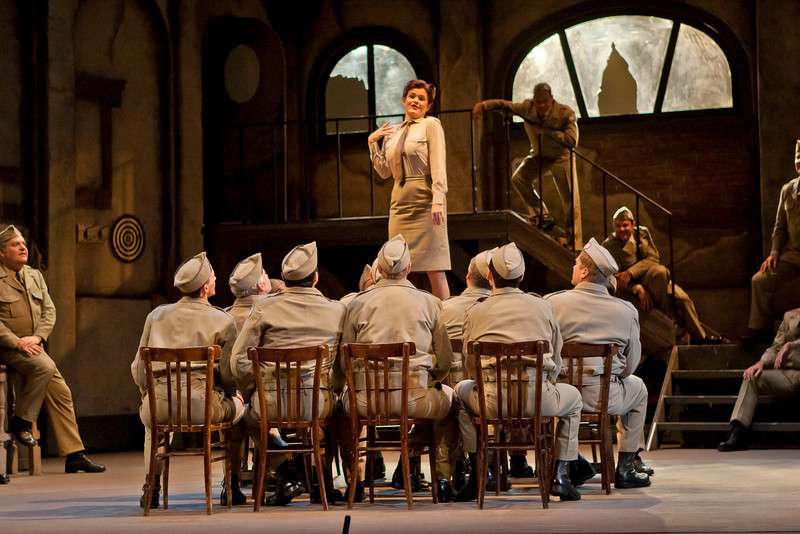|
Back
A comical, contemporary update San Diego
Civic Center
01/26/2013 - and 29 January, 1, 3 February 2013
Gaetano Donizetti: La Fille du régiment
L’ubica Vargicová (Marie), Stephen Costello (Tonio), Kevin Burdette (Sergeant Sulpice), Ewa Podleś (Marquise de Birkenfeld), Malcolm MacKenzie (Hortensio), Scott Sikon (Corporal), Carol Vaness (Duchess of Krakenthorp), Enrique Toral (A Peasant), San Diego Opera Chorus, Charles Prestinari (Chorus Master), San Diego Opera Orchestra, Yves Abel (Conductor)
Emilio Sagi (Director), Julio Galán (Original Set and Costume Designer), Marie Barrett (Lighting Designer), Steven W. Bryant (Wig and Makeup Designer)

(© J. Katarzyna Woronowicz)
Unveiling San Diego Opera’s 2013 season is Emilio Sagi’s debut interpretation of Gaetano Donizetti’s bubbly opéra comique, La Fille du régiment which, despite its pockets of memorable moments, brings more questions than answers. In Performances Magazine Mr. Sagi is quoted as saying, “In my view, he [Gaetano Donizetti] wanted to create an out-and-out comedy, but one tinged with nostalgia and people with sympathetic character rather than caricatures.” And while a certain amount of pathos and affection surfaces, the depth is tepid. Ernst Lubitsch’s film influences pervade the protagonists with bordering vulgarity (Lubitsch was known to be amused by sex) turning characters into caricatures. Here we see a greater realm of Jacques Offenbach’s opéra bouffe than Gioachino Rossini’s opera buffa.
The timeline moves to post World War II: now billed as The Daughter of the Regiment (vs. La Fille du régiment.) We now have American forces and a French spy instead of a French Army and a Tyrolean suspect. Late Mexican designer Julio Galán’s reconstruct of the Act I French café bunker is meticulously detailed, but the stairway squeezes the chorus into ascending and descending in single file, creating a barrier that entrees unimaginative and static choreography. Offsetting this family-run bar is Act II’s Chez Marquise drawing room favoring effectual Art Deco interior. A colorful punch of period-appropriate costuming is addressed in Act II compared to the uniformed, cohesive neutral palette display for the American regiment in the opening act.
Last seen in 2009’s Rigoletto, L’ubica Vargicová amply tackles the demanding score of Marie, but in Act I she clumsily moves about in a tightly drawn skirt that literally hampers her voice. Once dressed in greater fashion (Act II), this allows her register and acting to move about more freely. Vargicová sings best in her middle register. Indeed, she has moments of vocal respectability, but high notes are attacked.
American tenor Steven Costello’s delivery is polished and direct, but his acting is a bit rigid. Tonio’s nail biting “Pour mon âme” finds Costello hitting the nine high Cs with an introductory staccato adding a splendid, dramatic extension, and he effortlessly holds on to the concluding note with charismatic tenuto. It’s one the most memorable highlights of the opera.
Kevin Burdette makes his debut as Sergeant Sulpice, adding lively punch to the performance. While the bass’ register is resolute and projected with excellence, the acting reminds us of the Marx Brothers, and it gets overstated. Caricature abounds, and it’s entertaining.
We get back to the “Lubitsch touch” featuring ancillary antics of a window washer (also butler) and maid in Act II that pull the rug right out from under the four principals: Tonio, Marie, Sulpice and the Marquise. Non credited roles steal the show while Donizetti’s beautiful music (along with duets and trios) are subordinate. Local geographic surnames are inserted into the supertitles as guests usher into the drawing room leaving no sexual persuasion behind. Even Dame Edna (?) appears. The PR department is in full swing when Carol Vaness, in the role of the Duchess of Krakenthorp, is abruptly stopped from singing “Mon cśur s’ouvre ŕ ta voix”, a lighthearted reminder of San Diego Opera’s upcoming opera, Samson et Dalila.
By far, Ewa Podleś is the most entertaining and credible of all principals as the buffoonish and tawdry Marquise de Birkenfeld. ConcertoNet’s Matthew Martinez caught up with Ms. Podleś ahead of the performance (Read here) where Ms. Podleś clearly outlines the divinity of such roles, having remarkable reach within three octaves to qualify her as a fully talented and well qualified contralto. Her extraordinary acting and singing lives up to Emilio Sagi’s specifications.
Charles F. Prestinari’s chorus has a handful of powerful moments, and yet, at times, they struggle with Yves Abel’s pacing. French horns have their fair share of challenges in the Overture, but the orchestra finds its comfort zone well into Act I.
Bits and pieces of this La Fille du régiment (or in this production known as The Daughter of the Regiment) have dashing displays. Audiences will likely be amused and better relate to the more contemporary look of Donizetti’s comedy. Nonetheless, dignity draws its line, and there remains the question of whether or not it was crossed.
Christie Grimstad
|